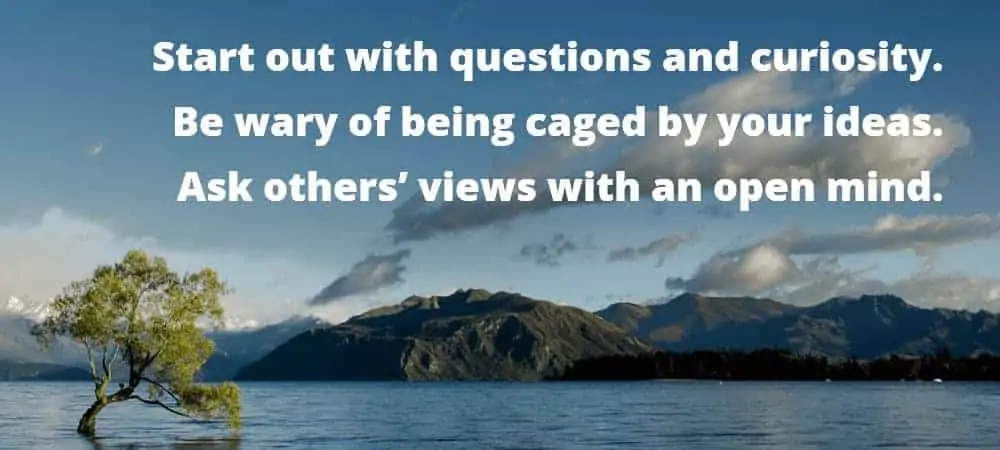Today's Thursday • 9 mins read
Confirmation bias is a mental prejudice.
It makes you more likely to believe what you already believe and ignore what you don’t believe. It’s why you tend to forward or share messages that give a thumbs-up to your views.
It is a lazy mental shortcut. Yet it’s efficient, as it lets your brain conserve cognitive energy.
Our brains don’t have to work hard to think up new ideas or reasons when we simply validate information that backs up our existing knowledge or beliefs.
However, this efficiency comes at a cost, often leading to flawed reasoning, bad decisions, and a polarized worldview.
Confirmation bias = confirmation of prior information while discarding the contradiction.
So, how can you identify it, and what steps can you take to reduce your confirmation bias?
5 Core Strategies to Overcome Your Confirmation Bias
Overcoming confirmation bias is not a one-time fix but an ongoing practice of intellectual discipline.
Here are five core strategies to actively reduce confirmation bias in your thinking:
1. Know Your Biases and Emotional Triggers
Start with self-awareness. Recognize that you, like everyone, have some biases. This practice is called metacognition or “thinking about your thinking.”
- Acknowledge Your Biases: It may be painful to acknowledge that your biases are influenced by your upbringing, personal experiences, and social environment. But accepting their existence in your own mind is the first step.
- Monitor Your Emotions & Triggers: We often hurl personal insults when we are angry at a person, only to regret it later. Our emotions are powerful amplifiers of our biases. Monitor how emotions might be affecting your judgment. When you feel strong emotions, notice if you are uncritically accepting the confirming information and impulsively rejecting contradictory evidence.
- Identify and Pause: Create a space between the stimulus and the response. Notice when you feel anger, defensiveness, or shame. Jot down the people or topics that spark these reactions. When these emotions spike, step away from the situation. Use techniques like diaphragmatic breathing to regain calm before re-engaging.
2. Diversify Your Information Diet
An echo chamber is the natural habitat of confirmation bias. It’s an environment in which you’re exposed to only those beliefs and opinions that agree with your own.
To break out, you must intentionally expose yourself to a wider range of perspectives.
- Seek Information From Various Sources: The more you know, and the more diverse the sources, the better your chance of forming an unbiased opinion. Actively search for information from a wide range of sources, including those with opposing viewpoints.
- Go Beyond Your Usual Lane: Make a conscious effort to rotate through news outlets with different political leanings, follow thoughtful opposing voices on social media, and read books or articles from authors outside your typical sphere of interest.

3. Actively Challenge Your Beliefs and Assumptions
Passive consumption of information is not enough. You must become an active and critical participant in your own thinking process.
- Play Devil’s Advocate: Don’t just be open to opposing views; actively seek them out. Deliberately look for data that could prove you wrong and explore alternative explanations for your conclusions. This aligns with the scientific principle of falsification—the idea that a belief is only robust if it can withstand attempts to disprove it.
- Actively Question Assumptions: Before locking in a view, ask yourself critical questions: “What evidence really backs this?”, “Could the opposite be true?”, and “What would it take for me to change my mind on this?”
- Vet Credibility and Use Evidence-Based Reasoning: Don’t just accept information at face value. Be critical of the sources. Check who produced the information, what their incentives might be, and whether the evidence presented is current, relevant, and methodologically sound. Weigh the evidence for and against all viewpoints before reaching any conclusion.
4. Engage in Dialogue and Seek External Perspectives
Your own mind can be a difficult place to escape. Involving others is a powerful strategy to reveal your blind spots.
- Talk to People with Different Viewpoints: Engaging with people who see the world differently opens your mind. The goal is not to “win” an argument but to understand their perspective. Put yourself in their shoes, ask clarifying questions, and listen without judgment.
- Perspective-taking. This is called cognitive empathy. Put yourself in others’ shoes to understand what they might be feeling or thinking, ask clarifying questions, and listen without judgment.
- Invite Feedback: Share your reasoning on a particular topic with trusted, thoughtful people, especially those who might disagree with you, and genuinely encourage them to poke holes in it. This creates a “challenge network” that helps keep your thinking sharp.
5. Cultivate a Mindset of Humility and Cognitive Flexibility
Ultimately, fighting confirmation bias is about your intellectual attitude. It requires decoupling your ego from your ideas.
- Be Humble and Open to Being Wrong: No one knows everything. Cultivate intellectual humility by recognizing that you might be wrong. If someone presents you with new, solid information that contradicts your existing beliefs, be open to changing your mind. It’s okay to be wrong; in fact, it’s a sign of growth.
- Stay Cognitively Flexible: Treat mistakes as data, not as personal failures. The goal is to update your beliefs willingly when new evidence emerges. Separate your identity from your opinions; an assault on your idea is not an assault on you.
- Be Patient and Reinforce Progress: It takes time and sustained effort to build these habits. Be patient with yourself. Acknowledge and even celebrate each time you recognize and correct your own confirmation bias to reinforce the practice and strengthen your critical thinking skills.

Social media post: “Question everything.”
The smartest comment: “Why?”
Why Do Humans Have Confirmation Bias?
The phrase “confirmation bias” was first used in a 1977 paper by Mynatt, Doherty, & Tweney. There are 3 types of confirmation bias:
- Biased Memory: When we remember supportive information while forgetting or overlooking contradictory information, this selective recall can reinforce our views over time.
- Biased Interpretation: When we interpret ambiguous evidence in a way that supports our beliefs, it may lead to misunderstandings and disputes.
- Biased Search For Information: When we actively seek out information that confirms our existing beliefs while avoiding or dismissing information that challenges them.
Why do we have confirmation bias?
1. To handle large amounts of information
Every day and even every minute, our brains get bombarded by limitless amounts of information from our environment. Confirmation bias is a quick and efficient way to process that large data.
If we were to always make an unbiased decision, we would have to objectively analyze every piece of information. That is impossible. Therefore, we only search for information to support our preconceived notions so that we can reach a decision or conclusion.
2. To reduce our cognitive dissonance
Surprisingly, confirmation bias tends to reduce another bias called cognitive dissonance.
Cognitive dissonance occurs when two opposing ideas or beliefs clash in our mind, urging us to discard one. Like, Stoics are happy people vs. Stoics are always talking about the end of life.
To keep the dissonance levels low, people use confirmation bias to ignore the knowledge that opposes their beliefs and find proof that confirms their beliefs.
3. To protect our self-esteem
According to Casad, 2019, people often resort to confirmation bias to guard their self-esteem and prove their views are right.
For example, we defend our support for a political party even when its scandal becomes public. It’s our self-esteem that we’re protecting here, since we said in the past, “These are good guys.”
Research On Confirmation Bias
- Nickerson, R. S. (1998). Confirmation bias: A ubiquitous phenomenon in many guises. Review of General Psychology.
- Lord, C. G., Ross, L., & Lepper, M. R. (1979). Biased assimilation and attitude polarization: The effects of prior theories on subsequent reasoning. Journal of Personality and Social Psychology, 37(6), 2098-2109.
- Klayman, J., & Ha, Y.-W. (1987). Confirmation, disconfirmation, and information in hypothesis testing. Psychological Review, 94(2), 211-228.
- Battaglio, R. P., Belardinelli, P., Bellé, N., & Cantarelli, P. (2018). Behavioral Public Administration ad fontes: a synthesis of research on bounded rationality, cognitive biases, and nudging in public organizations. Public Administration Review.
Final Words: The Story of Pete
An imaginary story. It didn’t happen in reality. Please play along.
It started with Pete dreaming up a marvelous idea that he believed would help people overcome a painful problem in their lives. He knew people were desperately missing it. He just had to get it out of his mind and build a real-world version of it. So, off he went.
Eleven months later, Pete’s painstakingly designed product hadn’t even sold twenty units. He had ensured there was a media blitz at launch and even ran ads for the last two months.
It was a visionary product, as any innovator could endorse.
Strangely, nobody wanted it.
So, he drew a deep breath of fresh air and finally decided to end the campaign and stop the money bleed. Hurt, he sat down and began questioning himself.
- Was he building a product for a problem that didn’t exist in the real world?
- Did he ever ask even one of his prospective customers if they actually wanted it?
- Was he building a solution to a need-gap that he realized after a sudden insight?
- Did he think he was right because his friends and everything he read on the internet said he was right?
The simple truth is this: he could not sell something to people that they never wanted to buy.
Maybe he could fool them once, but they would pay him back by running down his business and his reputation. They would avoid him if they were friends.
The way consumers think and behave is quite different now. He couldn’t tell them anymore, “This is what I believe in, and I know this is what you want.” No, they knew what they wanted better than he did.
Here comes the next batch:
- Was he trying to sell to people who actually had no shred of interest in him or his product, but he found that out later?
- Did he believe they would make an instant emotional decision to buy his product the moment he brought it out because all his analysis and data said so?
- Did he think he was the next Steve Jobs, who could live his entire life proving that people don’t know what they want until he showed them?
Let’s get this right. Those were the questions Pete should have asked himself before he went into the tunnel without a flashlight.
√ Also Read: 12+ Decision-Making Biases (Cognitive Biases Explained)
√ Please share this if you found it helpful.
» You deserve happiness! Choosing therapy could be your best decision.
...
• Disclosure: Buying via our links earns us a small commission.